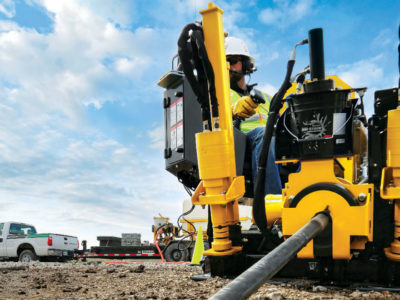How you drill depends on the ground condition you’ll be drilling in. Knowing the ground conditions, and adjusting your tooling and drill setup appropriately, is essential to getting the job done well. To help you know what you should consider in clay or loam, soft rock and hard rock, read (or watch) the tips below.
Boring in clay or loam
The pilot bore begins by pushing or rotating through rod and bit, following a predetermined path from entry point to exit point. In softer conditions like clay and loam, selecting a bit with a broad front profile will optimize steerability. A drier, compacted clay will require a bit with more of a point. Adding features like hardfacing and carbide buttons will help protect the bit as more difficult material is encountered.
Selecting the right drilling fluid is critical, as clay material will want to ball up around the drill bit or reamer, instead of flush cleanly from the hole. Select your additives based on whether the clay is reactive, which means it swells when moisture is added, or non-reactive, which means it doesn’t expand with extra moisture. Polymer-based drilling fluid additives are specially formulated to counteract the stickiness of clay.
Prior to drilling, it’s recommended that potholing with a vacuum excavator be performed to expose underground utilities.
For pullback, the right tooling is also critical. It’s recommended that a reamer at least one-and-a-half times the diameter of the installation is used, so there’s enough space for the product being installed and for adequate fluid flow at the exit or entrance flow. Drilling a larger hole allows sufficient space to remain once the hole is fully dry. If there isn’t enough space, it can lead to higher pressures downhole and cause inadvertent returns.
Boring in soft rock
There are many things to consider when drilling in soft rock with a psi threshold below 4,500 psi (31 MPa), such as sandstone, shale, soft limestone, caliche and some coral.
The pilot bore begins by pushing and rotating drill pipe following a predetermined path from the entry point to exit point. There’s a massive range of horizontal directional drilling drill bits, designed to work in rocky grounds, including the Vermeer Ace™ bit.
The drilling fluid you should use in rock will depend on the tooling and drill setup you choose. You want to go with a mix that has the right viscosity and gel strength to float cuttings away from the drill path, while providing adequate cooling and lubrication to the drill bit. Due to the difficulty of rock ground conditions, contractors need to modify their expectations on daily footage goals, and operators should modify their steering and how they manage the established bore path, such as the use of the carve steering method.
Prior to drilling, it’s recommended that potholing with a vacuum excavator be performed to expose underground utilities.
The right tooling is also critical for pullback in softer rock formations. It’s recommended that a fluted reamer and swivel be used, preferably with rotary or shark teeth. For more aggressive conditions, consider using a T-REX reamer.
Boring in hard rock
When drilling in hard rock with a psi threshold above 10,000 psi (68.9 MPa), such as hard limestone, granite and chert, there are several things you should know.
The pilot bore begins by pushing and rotating drill pipe following a predetermined path from the entry point to exit point. The tooling, from drill pipe, bits, housings and back reamers, should be designed specifically for rock applications.
The drilling fluid you should use in rock will depend on the tooling and drill setup you choose. You want to go with a mix that has the right viscosity and gel strength to float cuttings away from the drill path, while providing adequate cooling and lubrication to the drill bit. Due to the difficulty of rock ground conditions, contractors need to modify their expectations on daily footage goals, and operators should modify their steering and how they manage the established bore path, such as planning several rods ahead of the current location for steering.
The right tooling is also critical for pullback in hard rock formations. It’s recommended that a swivel and hole opener, like the Vermeer roller cone hole opener, be paired together.
As you can tell, there are many considerations when you’re drilling in clay or loam, soft rock and hard rock. Knowing these essentials can help you be equipped for your next jobsite. For more information on tooling or drills, contact your local Vermeer dealer.
Vermeer Corporation reserves the right to make changes in engineering, design and specifications; add improvements; or discontinue manufacturing at any time without notice or obligation. Equipment shown is for illustrative purposes only and may display optional accessories or components specific to their global region. Please contact your local Vermeer dealer for more information on machine specifications.
Vermeer, the Vermeer logo and Ace are trademarks of Vermeer Manufacturing Company in the U.S. and/or other countries. © 2022 Vermeer Corporation. All Rights Reserved.
